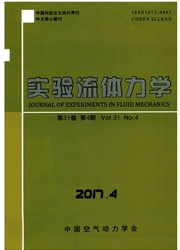

 中文摘要:
中文摘要:
高压水射流在油气资源钻探与增产领域应用日益广泛。但在井下作业时,射流一般处在很高的围压环境中,围压究竟对射流结构和能量传递有何影响是长期困扰着钻井领域的重要问题之一。通过围压水射流冲击压力测试装置,测得了不同围压条件下轴线冲击压力及射流压力。研究发现:憋压加载围压条件下,当围压小于喷嘴流量系数平方倍射流压力时,射流压力基本不变;围压较大时,射流压力随围压线性增加;围压对1倍喷距内的高压射流冲击压力基本没有影响;无因次射流轴向水力静压与无因次围压的3.3次方成正比,随无因次喷距线性增加,但当无因次围压超过阀值(0.6~0.7),水力静压将随围压线性增加;无因次轴线冲击压力与无因次围压的0.15次方成反比,而随无因次喷距线性减小,但超过阀值后基本不变。本研究可为钻井水力参数设计、冲砂洗井等井下作业提供一定参考。
 英文摘要:
英文摘要:
Hydraulic jetting techniques have found growing application in improving the rate of penetration (ROP) and enhancing oil recovery (EOR) in the oil and gas field. But it always encounters high confining pressure condition which may significantly weaken the performance of hydraulic jetting at the bottom of wells especially for the deep and ultra deep wells, so it is cruci ally important to study the effect of the confining pressure on the high pressure jetting. A hy- draulic jetting impact pressure measuring device which could generate low confining pressure (〈 10MPa) is used to measure the jet pressure and axial impact pressure. Results show that, with the method to build the confining pressure by changing the diameter of the outlet, the dimension- less jet pressure hardly changes until the dimensionless confining pressure exceeds a threshold which approximately equals to the square of the nozzle discharge coefficient, and from then on it increases with the confining pressure linearly; the confining pressure has no effect on the axial impact pressure within one nozzle diameter standoff distance; numerical fitting analysis show that the dimensionless axial hydrostatic pressure is proportional to the 3.3 power of the dimensionless confining pressure, and increases linearly with the dimensionless standoff distance; the dimen- sionless axial impact pressure is inversely proportional to the 0. 15 power of the dimensionless confining pressure, and decreases linearly with the dimensionless standoff distance; but if the di- mensionless confining pressure exceeds a threshold value which is between 0. 6 and 0.7 in our study, the axial hydraulic static pressure will be in accord with the confining pressure, and the axial impact pressure won't change. This study provides helpful instruction for the hydraulic {ac- tor design for drilling, sand-flushing operation, et al.
 同期刊论文项目
同期刊论文项目
 同项目期刊论文
同项目期刊论文
 期刊信息
期刊信息
